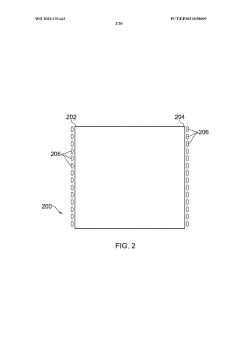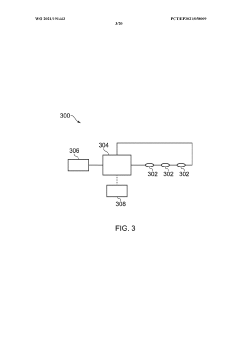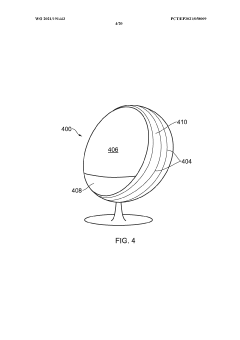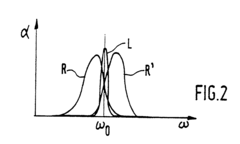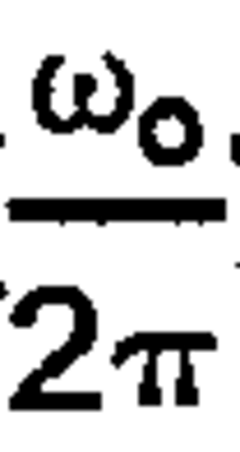How to Measure Schumann Resonance Accurately?
Schumann Resonance Background and Objectives
Schumann resonances, discovered by physicist Winfried Otto Schumann in 1952, are a set of spectrum peaks in the extremely low frequency (ELF) portion of the Earth's electromagnetic field spectrum. These resonances occur between the Earth's surface and the ionosphere, creating a natural cavity resonator. The fundamental frequency of Schumann resonances is approximately 7.83 Hz, with harmonics at higher frequencies.
The study of Schumann resonances has gained significant importance in various scientific fields, including atmospheric science, geophysics, and even potential applications in human health. Accurate measurement of these resonances is crucial for understanding global electromagnetic phenomena, monitoring changes in the Earth's atmosphere, and potentially detecting precursors to seismic activities.
The primary objective of measuring Schumann resonances accurately is to obtain precise data on the frequency, amplitude, and phase of these electromagnetic waves. This information is vital for researchers to analyze long-term trends, detect anomalies, and correlate Schumann resonance data with other geophysical and atmospheric phenomena. Accurate measurements can provide insights into global lightning activity, ionospheric dynamics, and even potential effects on biological systems.
Over the years, the technology for measuring Schumann resonances has evolved significantly. Early detection methods relied on simple antennas and analog recording systems, while modern techniques employ sophisticated digital signal processing and advanced sensor technologies. The challenge lies in isolating the weak Schumann resonance signals from the much stronger anthropogenic electromagnetic noise present in most environments.
Current research aims to develop more sensitive and reliable measurement techniques, capable of detecting subtle variations in Schumann resonances. This includes the development of advanced magnetometers, improved signal processing algorithms, and the establishment of global networks of monitoring stations. The goal is to create a comprehensive, real-time monitoring system that can provide high-resolution data on Schumann resonances worldwide.
As we look to the future, the accurate measurement of Schumann resonances holds promise for various applications. These include improved global weather forecasting, earthquake prediction, and even potential applications in space weather monitoring. The ongoing technological advancements in this field are expected to open new avenues for research and practical applications, making the accurate measurement of Schumann resonances a key area of focus in geophysical and atmospheric studies.
Market Applications of Schumann Resonance Measurement
Schumann resonance measurement has found diverse applications across various market sectors, driven by its potential to provide insights into global electromagnetic phenomena and their interactions with human health and technology. In the field of geophysics and atmospheric science, accurate Schumann resonance measurements are utilized to monitor global lightning activity and study the Earth's ionosphere. This data is valuable for climate research, weather prediction models, and understanding long-term atmospheric changes.
The healthcare industry has shown increasing interest in Schumann resonance measurements due to potential correlations between these natural electromagnetic frequencies and human well-being. Some researchers propose that exposure to Schumann resonances may have beneficial effects on human physiology, leading to the development of therapeutic devices and wellness products that aim to replicate or enhance these natural frequencies.
In the realm of telecommunications and electronics, Schumann resonance measurements play a crucial role in understanding and mitigating electromagnetic interference. As wireless technologies continue to proliferate, accurate measurement and characterization of these low-frequency electromagnetic waves become essential for designing robust communication systems and ensuring electromagnetic compatibility of electronic devices.
The aerospace and defense sectors utilize Schumann resonance measurements for various applications, including long-range communication systems and navigation technologies. These measurements can provide valuable data for improving the performance and reliability of systems operating in challenging electromagnetic environments.
Environmental monitoring and natural disaster prediction represent another significant market application for Schumann resonance measurements. Changes in Schumann resonance patterns have been associated with seismic activity and other geological phenomena, potentially offering early warning capabilities for earthquakes and other natural disasters.
The emerging field of precision agriculture has also begun to explore the applications of Schumann resonance measurements. Some researchers suggest that these natural electromagnetic frequencies may influence plant growth and crop yields, leading to the development of agricultural technologies that leverage this knowledge to optimize farming practices and increase productivity.
As the Internet of Things (IoT) and smart city technologies continue to evolve, Schumann resonance measurements may find new applications in urban planning and infrastructure management. These measurements could provide valuable data for optimizing wireless network performance, managing electromagnetic pollution, and creating more resilient urban environments.
Current Challenges in Schumann Resonance Detection
Despite significant advancements in Schumann resonance detection technology, several challenges persist in accurately measuring these low-frequency electromagnetic waves. One of the primary obstacles is the extremely low signal strength of Schumann resonances, typically in the range of a few picoTeslas. This weak signal is often overshadowed by various sources of electromagnetic noise, including human-made interference and natural phenomena such as lightning strikes and ionospheric disturbances.
The complex nature of the Earth-ionosphere cavity further complicates accurate measurements. The cavity's properties are not uniform and can vary significantly due to factors such as solar activity, geomagnetic storms, and seasonal changes. These variations can affect the resonance frequencies and amplitudes, making it challenging to obtain consistent and reliable measurements over extended periods.
Another significant challenge lies in the design and implementation of highly sensitive detection equipment. Sensors must be capable of detecting extremely weak signals while simultaneously filtering out unwanted noise. This requires sophisticated hardware and signal processing techniques, which can be both expensive and technically demanding to develop and maintain.
The geographical location of measurement stations also plays a crucial role in the accuracy of Schumann resonance detection. Ideal locations should be far from human-made electromagnetic interference, yet accessible enough for regular maintenance and data collection. Finding such locations, especially on a global scale for comprehensive monitoring, presents logistical and financial challenges.
Data analysis and interpretation pose additional difficulties. The complex nature of Schumann resonance signals, combined with various influencing factors, makes it challenging to extract meaningful information from raw data. Advanced signal processing algorithms and machine learning techniques are often required to separate the resonance signals from background noise and identify subtle variations that may be indicative of important geophysical phenomena.
Long-term monitoring of Schumann resonances is essential for understanding their behavior and potential applications in fields such as climate science and earthquake prediction. However, maintaining consistent measurement quality over extended periods presents its own set of challenges, including equipment degradation, calibration drift, and the need for continuous data validation and quality control.
Lastly, the interdisciplinary nature of Schumann resonance research necessitates collaboration between experts in various fields, including atmospheric physics, electrical engineering, and data science. Coordinating these diverse skill sets and integrating different perspectives can be challenging but is crucial for advancing our understanding and measurement capabilities of Schumann resonances.
Existing Methods for Accurate Schumann Resonance Measurement
01 Measurement and detection of Schumann resonance
Various devices and methods are developed to measure and detect Schumann resonance with improved accuracy. These include specialized sensors, antennas, and signal processing techniques to capture and analyze the low-frequency electromagnetic waves associated with Schumann resonance.- Measurement and detection of Schumann resonance: Various devices and methods are developed to measure and detect Schumann resonance with improved accuracy. These include specialized sensors, antennas, and signal processing techniques to capture and analyze the low-frequency electromagnetic waves associated with Schumann resonance.
- Schumann resonance generators and simulators: Devices and systems are designed to generate or simulate Schumann resonance frequencies with high accuracy. These generators can be used for research, therapeutic applications, or to create controlled environments for studying the effects of Schumann resonance.
- Integration of Schumann resonance in wearable devices: Wearable devices incorporating Schumann resonance technology are developed to improve accuracy in personal health monitoring and wellness applications. These devices aim to synchronize the user's biorhythms with the Earth's natural frequencies.
- Environmental monitoring using Schumann resonance: Systems and methods are developed to use Schumann resonance measurements for accurate environmental monitoring, including weather prediction, earthquake detection, and ionospheric studies. These applications rely on precise detection and analysis of Schumann resonance variations.
- Calibration and error correction in Schumann resonance measurements: Techniques and algorithms are developed to improve the calibration of Schumann resonance measurement equipment and correct errors in data acquisition. These methods aim to enhance the overall accuracy and reliability of Schumann resonance observations for scientific and practical applications.
02 Schumann resonance generators and simulators
Devices designed to generate or simulate Schumann resonance frequencies with high accuracy. These generators are used for research, therapeutic applications, or to create controlled environments that mimic natural Schumann resonance conditions.Expand Specific Solutions03 Wearable devices incorporating Schumann resonance technology
Development of wearable devices that can detect, generate, or interact with Schumann resonance frequencies. These devices aim to provide personal health benefits or environmental monitoring capabilities related to Schumann resonance.Expand Specific Solutions04 Environmental monitoring systems using Schumann resonance
Systems and methods for monitoring environmental conditions or natural phenomena using Schumann resonance measurements. These applications focus on improving the accuracy of detecting changes in the Earth's electromagnetic field for various purposes, including weather prediction or seismic activity monitoring.Expand Specific Solutions05 Signal processing and data analysis for Schumann resonance
Advanced signal processing techniques and data analysis methods to improve the accuracy of Schumann resonance measurements. These innovations focus on filtering out noise, enhancing signal quality, and extracting meaningful information from Schumann resonance data.Expand Specific Solutions
Key Players in Schumann Resonance Research
The measurement of Schumann Resonance is in a developing stage, with a growing market driven by increasing applications in geophysics, climate research, and health sciences. The technology's maturity is advancing, but challenges remain in achieving high accuracy due to the low-frequency nature of the resonance. Key players like Massachusetts Institute of Technology, Siemens Healthineers AG, and Robert Bosch GmbH are contributing to technological advancements. Universities such as Beijing Institute of Technology and University of Bern are also actively researching improved measurement techniques. The market is characterized by a mix of established electronics companies and specialized research institutions, indicating a competitive landscape with potential for further innovation and market expansion.
Robert Bosch GmbH
Massachusetts Institute of Technology
Innovative Technologies for Schumann Resonance Detection
- A magnetic field exposure system generating an amplitude-modulated low frequency magnetic field with a carrier frequency of 360 to 450 Hz and a modulation frequency of 0.5 to 100 Hz, with a field strength of 0.5 to 250 mT, specifically designed to expose organic cells or tissues to improve cell survival, proliferation, reduce stress, and enhance well-being.
- A method using a laser generator to excite transitions in the Schumann-Runge bands of molecular oxygen, measuring the ratio of fluorescence intensities from two overlapping absorption lines in different bands, with a very fine emission line and central frequency adjusted near the absorption lines' maxima, allowing for temperature deduction independent of oxygen density.
Environmental Factors Affecting Schumann Resonance
The Schumann resonance, a set of spectral peaks in the Earth's electromagnetic field spectrum, is highly susceptible to various environmental factors that can significantly impact its measurement accuracy. One of the primary influencing factors is solar activity. Solar flares and coronal mass ejections can cause disturbances in the Earth's ionosphere, leading to fluctuations in the Schumann resonance frequencies and amplitudes. These solar-induced variations can make it challenging to obtain consistent and accurate measurements.
Atmospheric conditions also play a crucial role in affecting Schumann resonance measurements. Changes in temperature, humidity, and air pressure can alter the conductivity of the atmosphere, thereby influencing the propagation of electromagnetic waves. Seasonal variations and diurnal cycles contribute to these atmospheric changes, necessitating long-term monitoring and data collection to account for these periodic fluctuations.
Geomagnetic activity is another significant environmental factor that can impact Schumann resonance measurements. Geomagnetic storms, caused by interactions between the Earth's magnetosphere and the solar wind, can introduce noise and distortions in the electromagnetic field. These disturbances can mask or alter the Schumann resonance signals, making accurate detection and analysis more challenging.
Human-made electromagnetic interference is an increasingly important factor affecting Schumann resonance measurements. The proliferation of electronic devices, power lines, and communication systems has led to a rise in anthropogenic electromagnetic noise. This background noise can obscure the relatively weak Schumann resonance signals, particularly in urban and industrialized areas. Consequently, researchers often seek remote locations with minimal human activity to conduct their measurements.
Geological factors can also influence Schumann resonance measurements. The Earth's crust composition and local geological structures can affect the propagation and reflection of electromagnetic waves. Areas with high mineral content or unique geological formations may experience localized variations in Schumann resonance characteristics, potentially leading to measurement discrepancies between different geographical locations.
Weather patterns and extreme meteorological events can have both direct and indirect effects on Schumann resonance measurements. Thunderstorms, which are the primary source of excitation for Schumann resonances, can cause temporary increases in signal strength and frequency shifts. Additionally, large-scale weather systems can alter the ionospheric conditions, affecting the resonance cavity and, consequently, the measured resonance parameters.
Data Analysis and Interpretation Techniques
Accurate measurement of Schumann Resonance requires sophisticated data analysis and interpretation techniques. The process begins with signal preprocessing, which involves filtering out unwanted noise and interference from the raw electromagnetic data. This step is crucial for isolating the Schumann Resonance frequencies from background electromagnetic activity. Various digital filtering techniques, such as bandpass filters and notch filters, are commonly employed to enhance the signal-to-noise ratio.
Once the data is preprocessed, spectral analysis techniques are applied to identify and characterize the Schumann Resonance peaks. Fast Fourier Transform (FFT) is a widely used method for converting time-domain signals into the frequency domain, allowing researchers to visualize the power spectrum of the Schumann Resonance. Advanced spectral estimation methods, such as the Welch method or multitaper spectral analysis, can provide more robust and accurate estimates of the resonance frequencies and amplitudes.
Time-frequency analysis techniques, like wavelet transforms or short-time Fourier transforms, are valuable for studying the temporal variations of Schumann Resonance. These methods enable researchers to observe how the resonance characteristics change over time, which is particularly important for investigating the influence of solar activity, ionospheric conditions, and other geophysical phenomena on the Schumann Resonance.
Statistical analysis plays a crucial role in interpreting Schumann Resonance data. Techniques such as correlation analysis, regression analysis, and time series analysis are used to identify relationships between Schumann Resonance parameters and various environmental and geophysical factors. These methods help researchers understand the complex interactions between the Earth's electromagnetic field and other natural phenomena.
Machine learning and artificial intelligence algorithms are increasingly being applied to Schumann Resonance data analysis. These techniques can help identify patterns and anomalies in large datasets, potentially revealing new insights into the behavior of the Earth's electromagnetic environment. Neural networks and deep learning models have shown promise in predicting Schumann Resonance variations and extracting features that may not be apparent through traditional analysis methods.
Visualization techniques are essential for presenting and interpreting Schumann Resonance data effectively. Advanced plotting libraries and data visualization tools allow researchers to create informative spectrograms, time series plots, and 3D representations of the resonance patterns. These visual aids are invaluable for communicating complex findings to both scientific and non-scientific audiences.

